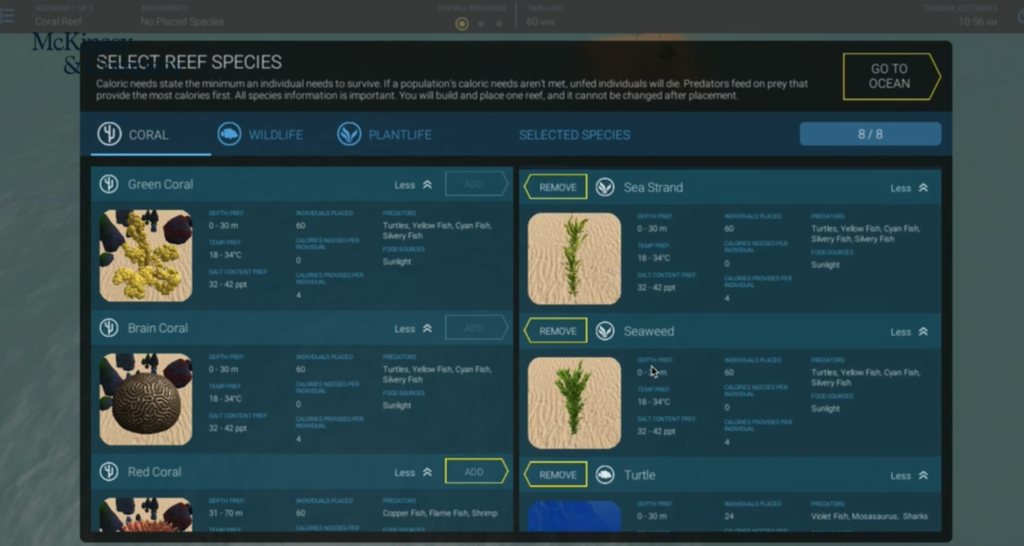An Excel template can be used in the Ecosystem Building, the most commonly met game in the McKinsey Solve Assessment, to assist candidates in quickly analyzing massive amount of data. This strategy is versatile and has been confirmed by many candidates to increase their efficiency.
This article will explain the purposes and benefits of using Excel in the Ecosystem Building game. It will also gives instructions on how to best use it.
Overview of The Ecosystem Building Game
In the game “Ecosystem Building,” players have to choose 8 of the available 39 species to build a sustainable ecosystem. Players have to create a continuing food chain with an excess of calories for each species with the right terrain conditions in order to accomplish this.
The Ecosystem Building game usually takes the scenario in a coral reef, on a mountain ridge or in the jungle. Each location and species have its own characteristics, which require different approaches. They can, however, be tackled using the same strategy, which we’ll talk about in more detail in a bit.
The Ecosystem Building game typically takes candidates 35 minutes to complete. So the biggest challenge is how to analyze the massive amount of information given by the game. Players will need to find useful clues among between 241 and 320 pieces of data in a short amount of time. Players who are not used to the game’s format will have a hard time because they don’t know which information points they should concentrate on. That is how Excel templates came useful in the Ecosystem Building game.
The Need for Excel in The Ecosystem Building Game
The purpose of using Excel in the game
The PSG Excel template was developed to categorize and refine the information obtained from the minigames in a logical way. It not only serves as a tool to store and organize the data that is presented in the mini-games, but also gives players a better overview of the tasks and makes it easier to identify relationships between them.
Candidates can use the two Excel sheets to guide them through the three steps of playing the Ecosystem Building game:
- Select an area that will work well for the ecosystem and place it there. Typically, these are the sites where producers with the highest caloric intake can reside in.
- Create a sustainable food chain in which no species goes extinct at the end of the consuming cycle.
- Go over all aspects of the ecosystem, from the need for a specific location to the availability of food sources.
Candidates applying for McKinsey positions can use these steps to demonstrate a structured approach to problem-solving. The PSG Excel template makes it easier for candidates to organize their data more effectively and logically, which in turn simplifies the process of developing a problem-solving approach.

The main benefits of using Excel in the game
If candidates use the PSG Excel template, it will be easier for them to navigate the vast amount of information that is contained within Ecosystem Building. The template can provide guidance on where to begin and how to move forward. By outlining the key elements of a problem in the Ecosystem Building game, the template makes it easier for candidates to quickly understand the core of an issue, find a structure for a solution, and optimize their approach.
Using Excel templates in the Ecosystem Building game can help candidates save time on calculations. Calculating in the minigames successfully requires the use of mental math, but it’s inevitable that players will make mistakes. That’s why it’s helpful to have a tool like Excel at your disposal for quick and precise calculations. They can use it to compile all the necessary information, format it with columns and formulas (even ahead of time!), and simplify the entire procedure.
Filtering out irrelevant information will be a breeze with the Excel template’s help. There is a lot of data in the Ecosystem Building game, but not all of it is essential. With an Excel template, it is possible to ignore the noise data and instead zero in on the relevant data that will lead to the solution.
Using Excel in The Ecosystem Building Game
Employing PSG Excel template effectively requires careful management of two spreadsheets, each for a seperate mission. First is for location and species selection, second is for food chain continuity.
Location and species selection
- Step 1: Create two tables categorizing the key statistics of locations and species respectively.
- Location: Depth/elevation, temperature, etc.
- Species: Calorie intake, calorie output, class, environmental requirements, etc.
- Step 2: Filter through the data. Fill out the Location table with the coordinates for the ranges where the most productive plants overlap in environmental requirements.
- Step 3: Review the Species table and pick out only those who have properties that correspond to the selected location.

Source: McKinsey’s “Solve, Assessment Game Video”
Food chain continuity
- Step 1: Group the species into seperate boxes
- Herbivores (turn plants into meat)
- Apex predators (ideally the one with the most prey and the fewest energy requirements)
- Intermediate predators
- Primary consumers (use soil and sunlight to create nutrients)
- Step 2: Decide on which method to approach the game with: top-down or botom-up. Use the boxes accordingly.
- Step 3: Once each eating cycle is finished, take note of the “End” calorie totals.
Tips on Using Excel in The Ecosystem Building Game
We have a few additional suggestions for employing the PSG Excel template in addition to the directions provided:
- Use 2 monitors: the McKinsey’s Assessment will take up the entire screen. It also detects your mouse movements that are irrelevant to the game so it’s best to use another computer.
- Pay close attention to the game’s instructions: It’s important to have a comprehensive understanding of Ecosystem Building’s many rules and parts. If you don’t have a firm grasp of the game’s requirements, the Excel template won’t help you much. You might even waster more time.
